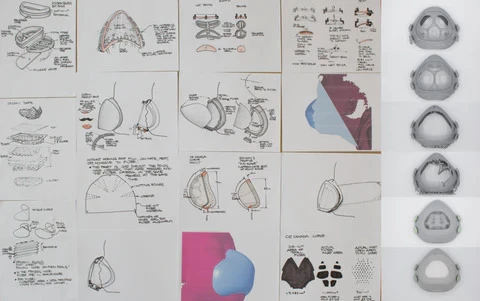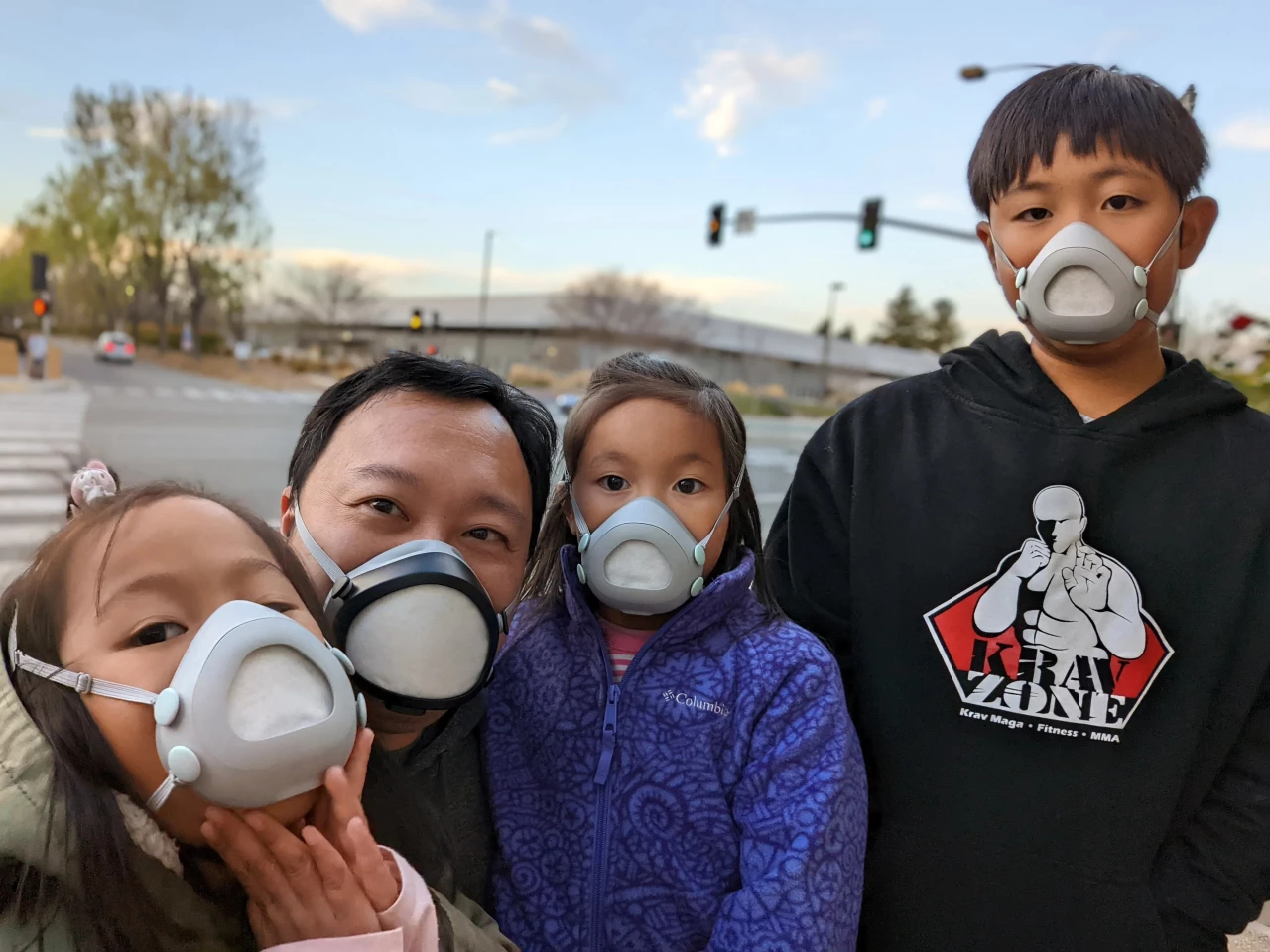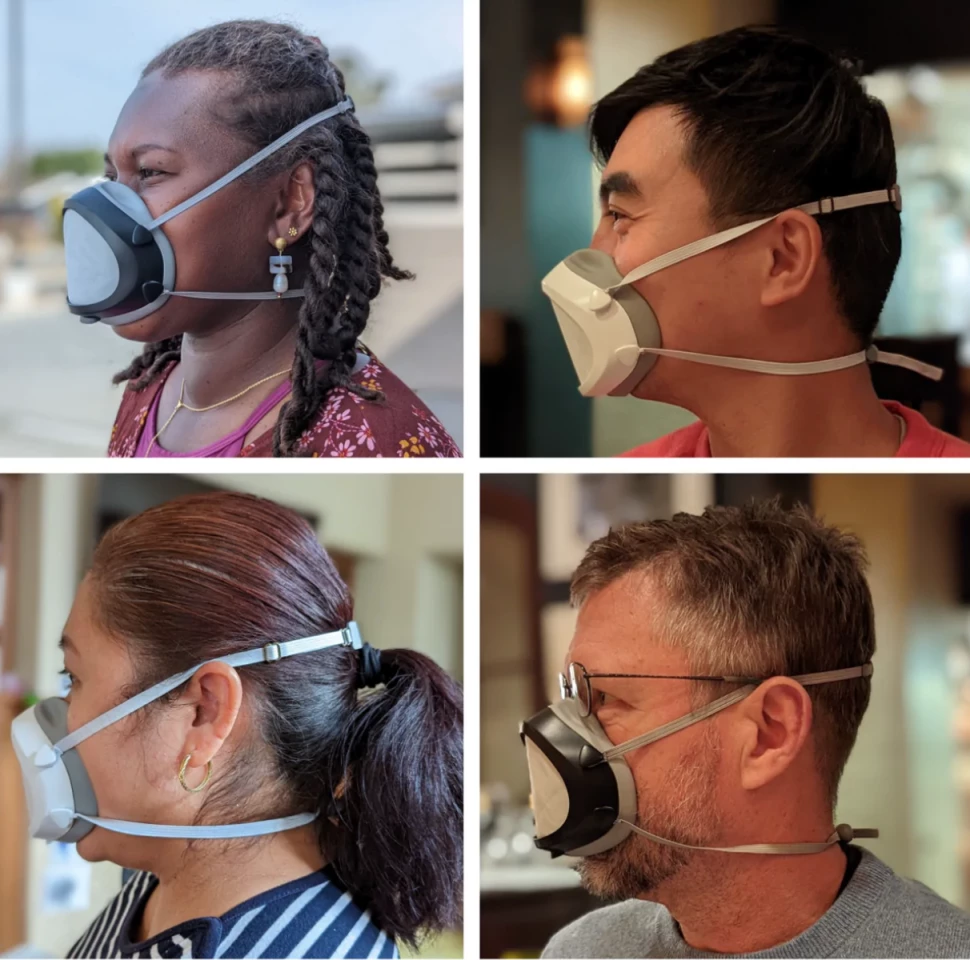Remember when everyone was experimenting with different kinds of cloth face mask designs back in 2020? For many, the frustration of mask wearing could be offset by the creative ways cloth masks were decoratively deployed.
As the pandemic wore on, new SARS-CoV-2 variants emerged and we learned more about how this novel virus spread. Cloth masks simply weren’t enough, so many people shifted to using surgical masks. But soon it became clear they weren’t that effective either. In a world permanently changed by the emergence of the stunningly infectious Omicron variant, well-fitted N95 masks became the only real option for those seeking good protection from this airborne virus.
Now it’s 2022, and you could be forgiven for pausing a moment before you put in an order for yet another box of disposable N95 masks. There has to be a more efficient way. This virus is not going to suddenly disappear, so is the future going to be an endless cycle of buying and dumping disposable masks?
The accumulating waste problem from disposable masks is nothing short of catastrophic. Not only are hundreds of millions of face masks disposed of every single day, but the plastic fibers in the masks are adding to a frightening microplastic problem. One recent study found masks can easily leach plastics into waterways.
The solution seems simple – reusable face masks. And they do already exist. They are known as elastomeric respirators, and most of us are probably familiar with their two-chambered gas mask aesthetic. They certainly don’t look elegant, and have never really taken off in health care contexts.
But traditional elastomeric respirators look the way they do because of fundamental technological limitations. To make a respirator with 95 to 99% filtration, you need a fair bit of surface area. Every time you inhale, all the air coming in needs to move through a thick filter, so the bigger the surface area the less a wearer feels like they are trying to pull each breath through a thick cloth.

Can there be a better way?
This is exactly what Flo Mask creator Kevin Ngo wondered all the way back in 2018. Devastating wildfires that year led to his neighborhood in the San Francisco Bay Area being blanketed with toxic smoke for several weeks. He quickly whipped on a N95 but struggled to find something that worked well for his children.
“And that's when I said, 'you know what, there's got to be a solution out there, I make products for a living, I'm gonna find the best mask that they make for kids,'” Ngo explains in an interview with New Atlas. “Because I'm wearing an N95 to work, and if I'm already getting headaches, my eyes are burning and tearing up from all the wildfires smoke, I can only imagine what, you know, a kindergartener or third grader’s feeling at the time.”

Ngo is your classic Silicon Valley geek. For the better part of 20 years he has worked in product development for everyone from Logitech to Motorola. He currently works at Google, and after a frustrating evening in 2018 searching all over the internet for a good kids' mask he realized what he needed simply didn’t exist.
So what does a Silicon Valley tech guy do when he realizes what he needs doesn’t exist? He gets a bunch of friends, all award-winning product designers, and spends two years developing the best kids mask they can imagine. Ngo called in favors from all over the tech world as he tinkered with the designs for a kids' mask. Every step of the way he came across other parents willing to help out to make this thing a reality – from wrangling weekend use of one of the most advanced 3D scanners in the world to scan dozens of child faces, to leveraging silicone mold knowledge from designers on the team familiar with popular commercial products.

And then … 2020
The pandemic hit just as Ngo was at the tail end of his first kids' Flo Mask development. By the end of 2020, the kids' Flo Mask was out but the world of pandemic masks still hadn’t caught up to where Ngo was. His perfectly sealed elastomeric masks seemed overkill in a world playing around with cloth and surgical masks.
As time passed, demand grew for an adult iteration of the Flo Mask. The problem was an adult mask is a much more complicated design challenge. Kids' faces are relatively uniform, so getting close to a one-size-fits-all design wasn’t too hard. Plus, new kinds of filters would be needed for adult masks to get up above the 95% efficiency expected by people currently wearing N95 masks.
The big eureka moment, according to Ngo, came when he learned a next-generation filter material had been developed in late 2019. Initially, the material was only being used by the Department of Defense but due to a random confluence of events, Ngo got his hands on a load and went about testing its efficiency.
The results were the game changer he needed to create the adult mask. Testing the material revealed it had the ability to filter with 99% efficiency over a tiny surface area while maintaining extraordinary breathability.
“So if you think about the science of masks, the machine [that tests filter efficiency] uses a surface area of 100 centimeters squared,” Ngo explained. “In order to hit N95 the masks they test covers up almost 100 centimeters squared. So filtration surface area correlates to how high the efficiency is. You're getting about 95%, or better, at 100 centimeters squared. The filter for flow mask, it's 57 centimeters squared, so almost half the size, but we're still getting 99% filtration, with equivalent breathability of an N95, if not better. So this is next level stuff. And that's how we're able to achieve what we've achieved.”

The face challenge
The other big challenge for designing the adult Flo lay in trying to accommodate the breadth of adult face shapes. Again, the team looked at a mass of 3D face scans and came up with two design iterations based on nose bridge size – a low to medium size for people of Asian and African decent, and a medium to high nose bridge size for those of European descent.
Ngo calculated between these two sizes, around 90% of all adults should be accommodated by the Flo Mask. But now the mask is out in the real world it's turning out 90% was an underestimate.
“We have a success rate of 98% which is pretty phenomenal,” Ngo explained, after the company has now been shipping masks out to customers for a few months. “Considering we felt like, you know, we could get nine out of 10 users in our mask, of the users who have bought we're getting 98%, which is like pretty spectacular.”

All in all, the mask went through at least a dozen design iterations before the final version was settled upon. From painstaking work getting a glass indentation perfectly placed in the silicone mold, to working out the optimal way for the filters to sit over the mask, the attention to detail in the Flo Mask is impressive.
Nevertheless, there are still challenges ahead, particularly in navigating the slow bureaucracy of N95 certification. For a mask like this to be formally certified as N95 or higher in the United States it needs to go through an organization called NIOSH (National Institute for Occupational Safety and Health), which Ngo said may take some time.
But the Flo Mask has been selected to be a finalist in a Mask Innovation Moonshot Challenge, spearheaded by several US government agencies including NIOSH, BARDA (Biomedical Advanced Research and Development Authority), and NIST (National Institute of Standards and Technology).
In the spirit of absolute transparency, Ngo makes no claims to Flo Mask being equivalent to an authorized N95. However, as part of the Mask Innovation Challenge, the Flo Mask has been through NIOSH’s testing protocol and those results have been published on YouTube.
Why are we still using disposable masks?
Trying on the Flo Mask for the first time was a pretty eye-opening experience. After battling ill-fitting, tight, uncomfortable, disposable N95 masks for months, the Flo's silicone gasket instantly created a surprisingly good seal. The filter was easy to breathe through and my voice wasn’t muffled at all talking through it.
The only slightly unusual aspect was the way the mask is designed to sit above my chin. Two years of wearing various masks that sit under my chin meant it certainly took a few moments to adjust to the very unique way the Flo Mask sits on the face.
After a few days of using the Flo Mask I was left with one big question: Why aren’t these kinds of elastomeric respirators widely used? Sure, the imposing qualities of older two-chamber respirators may have presented an unfavorable aesthetic for health care environments in the past, but that’s not a problem anymore.
A recent New York Times investigation into elastomeric masks had one major researcher describing the lack of adoption in health care contexts as puzzling. Emily Haas, a scientist working for NIOSH, suggested the biggest challenge in moving hospitals from disposable N95s to reusable respirators is cultural. These health care environments have for decades used disposable masks and changing that norm will take work.
“There’s been so much research in the last 10 years that has really supported elastomerics, so in some ways the issue right now is cultural,” Haas said. “No one likes change, and introducing a whole new system of respiratory protection can be a heavy lift.”
The US-government-led Mask Innovation Challenge seems to be part of an attempt to change these old behaviors. And Flo Mask is certainly one of the Challenge’s finalists with the potential to radically alter the way we think about masks.
But right now, Flo Mask is still a labor of love for Ngo. Talking to New Atlas at 10 pm on a weeknight, after a day’s work at Google and an evening spent with his kids, it’s clear the years of work put into the Flo Mask have been all done in his spare time with thousands of dollars of personal savings on the line. And so far, the business is still run mostly by him, responding to emails from customers at midnight in between family life and a day job.
Styling my @flo_mask and rainbow safety glasses with a #MassEffectAndromeda theme for #comiccon2022 pic.twitter.com/A5cynZGSie
— nic (@nickelpin) July 21, 2022
Today in testing the @flo_mask Pro:
— ポーラカタリーナ #COVIDisAirborne (Mask-o-genic era) ⭐🧣 (@paulakatarina) July 16, 2022
☑️ Used the Everyday Filter & inhaling feels fine. No odd plasticky smells. Feels quite cool underneath w/o air leaks on exhalation.
☑️ Unlike w/ N95s, it doesn't get dislodged while speaking. Chin is free!
1/🧵 #COVIDisAirborne #CovidIsNotOver pic.twitter.com/cpPzILecZp
Ngo is justifiably proud of what he has created, and for a product that entered the world with zero marketing it’s slowly snowballing via word-of-mouth as social media channels light up with constant streams of positive user reports. Scrolling through Flo's Twitter account delivers a torrent of people sharing images of themselves proudly wearing the mask after somehow finding out about the Flo.
“I don't claim to know everything, but I've learned a lot [while developing the Flo Mask],” said Ngo. “And I feel like this is hands down the best mask anyone's ever made. Because we're taking these ginormous respirator elastomerics that you've seen for decades, and we've taken it to a size that is unheard of, with the same level of protection or almost equivalent. And, you know, it's kind of weird that a few tech guys who love making products happen to have built the best mask in the world.”








